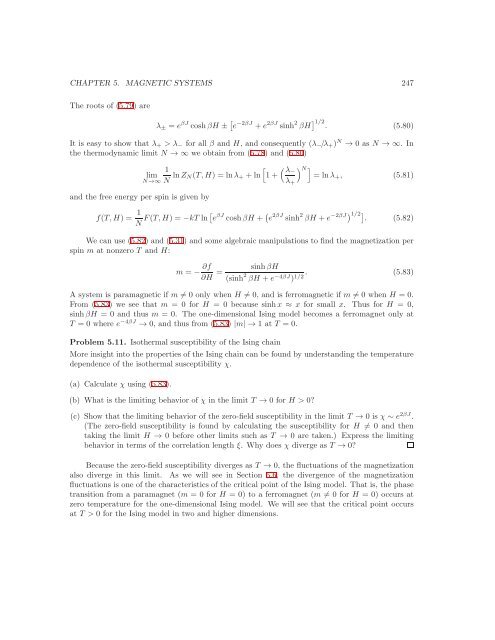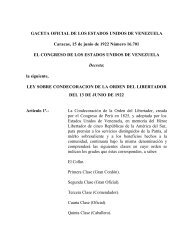Chapter 5 - WebRing
Chapter 5 - WebRing
Chapter 5 - WebRing
You also want an ePaper? Increase the reach of your titles
YUMPU automatically turns print PDFs into web optimized ePapers that Google loves.
CHAPTER 5. MAGNETIC SYSTEMS 247<br />
The roots of (5.79) are<br />
λ± = e βJ coshβH ± e −2βJ +e 2βJ sinh 2 βH 1/2 . (5.80)<br />
It is easy to show that λ+ > λ− for all β and H, and consequently (λ−/λ+) N → 0 as N → ∞. In<br />
the thermodynamic limit N → ∞ we obtain from (5.78) and (5.80)<br />
1<br />
lim<br />
N→∞ N lnZN(T,H)<br />
<br />
= lnλ+ +ln 1+<br />
and the free energy per spin is given by<br />
λ−<br />
λ+<br />
N = lnλ+, (5.81)<br />
f(T,H) = 1<br />
N F(T,H) = −kT ln e βJ coshβH + e 2βJ sinh 2 βH +e −2βJ 1/2 . (5.82)<br />
We can use (5.82) and (5.31) and some algebraic manipulations to find the magnetization per<br />
spin m at nonzero T and H:<br />
m = − ∂f<br />
∂H =<br />
sinhβH<br />
(sinh 2 βH +e −4βJ ) 1/2.<br />
(5.83)<br />
A system is paramagnetic if m = 0 only when H = 0, and is ferromagnetic if m = 0 when H = 0.<br />
From (5.83) we see that m = 0 for H = 0 because sinhx ≈ x for small x. Thus for H = 0,<br />
sinhβH = 0 and thus m = 0. The one-dimensional Ising model becomes a ferromagnet only at<br />
T = 0 where e −4βJ → 0, and thus from (5.83) |m| → 1 at T = 0.<br />
Problem 5.11. Isothermal susceptibility of the Ising chain<br />
More insight into the properties of the Ising chain can be found by understanding the temperature<br />
dependence of the isothermal susceptibility χ.<br />
(a) Calculate χ using (5.83).<br />
(b) What is the limiting behavior of χ in the limit T → 0 for H > 0?<br />
(c) Show that the limiting behavior of the zero-field susceptibility in the limit T → 0 is χ ∼ e 2βJ .<br />
(The zero-field susceptibility is found by calculating the susceptibility for H = 0 and then<br />
taking the limit H → 0 before other limits such as T → 0 are taken.) Express the limiting<br />
behavior in terms of the correlation length ξ. Why does χ diverge as T → 0?<br />
Because the zero-field susceptibility diverges as T → 0, the fluctuations of the magnetization<br />
also diverge in this limit. As we will see in Section 5.6, the divergence of the magnetization<br />
fluctuations is one of the characteristics of the critical point of the Ising model. That is, the phase<br />
transition from a paramagnet (m = 0 for H = 0) to a ferromagnet (m = 0 for H = 0) occurs at<br />
zero temperature for the one-dimensional Ising model. We will see that the critical point occurs<br />
at T > 0 for the Ising model in two and higher dimensions.

















